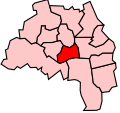| Gateshead East | |
|---|---|
| Former borough constituency for the House of Commons | |
 Boundary of Gateshead East in Tyne and Wear, boundaries 1983–1997 | |
| County | County Durham until 1974, then Tyne and Wear |
| 1950–1997 | |
| Seats | One |
| Created from | Gateshead |
| Replaced by | Gateshead East & Washington West, Tyne Bridge and Jarrow |
Gateshead East was a parliamentary constituency represented in the House of Commons of the Parliament of the United Kingdom from 1950 to 1997. It elected one Member of Parliament (MP) by the first past the post system of election.